Relationship between the Intraseasonal Oscillation over Mid-High-Latitude Eurasia and the Stratospheric Sudden Warming Event in February 2018
Abstract
:1. Introduction
2. Data and Methods
2.1. Data
2.2. Methods
3. Results
3.1. Overview of 2018 SSW Event
3.2. Signal of ISO over Mid-High-Latitude Eurasia
3.3. Relationship between the 2018 SSW Event and Mid-High-Latitude ISO
4. Discussion
5. Summary
Author Contributions
Funding
Data Availability Statement
Acknowledgments
Conflicts of Interest
References
- Charlton, A.J.; Polvani, L.M. A New Look at Stratospheric Sudden Warmings. Part I: Climatology and Modeling Benchmarks. J. Clim. 2007, 20, 449–469. [Google Scholar] [CrossRef]
- Butler, A.H.; Seidel, D.J.; Hardiman, S.C.; Butchart, N.; Birner, T.; Match, A. Defining Sudden Stratospheric Warmings. Bull. Am. Meteorol. Soc. 2015, 96, 1913–1928. [Google Scholar] [CrossRef]
- Scherhag, R. Die explosionartigen stratospharenwarmungen des spatwinters 1951–1952. Ber. Deut. Wetterd. 1952, 6, 51–63. [Google Scholar]
- Limpasuvan, V.; Thompson, D.W.J.; Hartmann, D.L. The Life Cycle of the Northern Hemisphere Sudden Stratospheric Warmings. J. Clim. 2004, 17, 2584–2596. [Google Scholar] [CrossRef]
- Matsuno, T. A Dynamical Model of the Stratospheric Sudden Warming. J. Atmos. Sci. 1971, 28, 1479–1494. [Google Scholar] [CrossRef]
- Charlton, A.J.; Polvani, L.M.; Perlwitz, J.; Sassi, F.; Manzini, E.; Shibata, K.; Pawson, S.; Nielsen, J.E.; Rind, D. A New Look at Stratospheric Sudden Warmings. Part II: Evaluation of Numerical Model Simulations. J. Clim. 2007, 20, 470–488. [Google Scholar] [CrossRef]
- Rao, J.; Garfinkel, C.I.; Chen, H.; White, I.P. The 2019 New Year Stratospheric Sudden Warming and Its Real-Time Predictions in Multiple S2S Models. J. Geophys. Res. Atmos. 2019, 124, 11155–11174. [Google Scholar] [CrossRef]
- Garfinkel, C.I.; Hartmann, D.L. Effects of the El Niño-Southern Oscillation and the Quasi-Biennial Oscillation on polar tem-peratures in the stratosphere. J. Geophys. Res. 2007, 112, D19112. [Google Scholar] [CrossRef] [Green Version]
- Hu, J.; Li, T.; Xu, H.; Yang, S. Lessened response of boreal winter stratospheric polar vortex to El Niño in recent decades. Clim. Dyn. 2016, 49, 263–278. [Google Scholar] [CrossRef]
- Polvani, L.M.; Sun, L.; Butler, A.H.; Richter, J.H.; Deser, C. Distinguishing Stratospheric Sudden Warmings from ENSO as Key Drivers of Wintertime Climate Variability over the North Atlantic and Eurasia. J. Clim. 2017, 30, 1959–1969. [Google Scholar] [CrossRef]
- Yang, S.; Li, T.; Hu, J.; Shen, X. Decadal variation of the impact of La Niña on the winter Arctic stratosphere. Adv. Atmos. Sci. 2017, 34, 679–684. [Google Scholar] [CrossRef]
- Ma, J.; Chen, W.; Nath, D.; Lan, X. Modulation by ENSO of the Relationship Between Stratospheric Sudden Warming and the Madden-Julian Oscillation. Geophys. Res. Lett. 2020, 47, e2020GL088894. [Google Scholar] [CrossRef]
- Salminen, A.; Asikainen, T.; Maliniemi, V.; Mursula, K. Dependence of Sudden Stratospheric Warmings on Internal and External Drivers. Geophys. Res. Lett. 2020, 47, e2019gl086444. [Google Scholar] [CrossRef]
- Madden, R.A.; Julian, P.R. Detection of a 40–50 day oscillation in the zonal wind in the Tropical Pacific. J. Atmos. Sci. 1971, 28, 702–708. [Google Scholar] [CrossRef]
- Garfinkel, C.I.; Feldstein, S.B.; Waugh, D.W.; Yoo, C.; Lee, S. Observed connection between stratospheric sudden warmings and the Madden–Julian Oscillation. Geophys. Res. Lett. 2012, 39, e2012gl053144. [Google Scholar] [CrossRef] [Green Version]
- Garfinkel, C.I.; Benedict, J.J.; Maloney, E.D. Impact of the MJO on the boreal winter extratropical circulation. Geophys. Res. Lett. 2014, 41, 6055–6062. [Google Scholar] [CrossRef]
- Wheeler, M.C.; Hendon, H.H. An all-season real-time multivariate MJO index: Development of an index for monitoring and prediction. Mon. Weather. Rev. 2004, 13, 1917–1932. [Google Scholar] [CrossRef]
- Wang, F.; Tian, W.; Xie, F.; Zhang, J.; Han, Y. Effect of Madden–Julian Oscillation Occurrence Frequency on the Interannual Variability of Northern Hemisphere Stratospheric Wave Activity in Winter. J. Clim. 2018, 31, 5031–5049. [Google Scholar] [CrossRef]
- Anderson, J.R.; Rosen, R.D. The Latitude-Height Structure of 40–50 Day Variations in Atmospheric Angular Momentum. J. Atmos. Sci. 1983, 40, 1584–1591. [Google Scholar] [CrossRef] [Green Version]
- Yang, S.; Wu, B.; Zhang, R.; Zhou, S. Propagation of low-frequency oscillation over Eurasian mid-high latitude in winter and its association with the Eurasian teleconnection pattern. Chin. J. Atmos. Sci. 2014, 38, 121–132. (In Chinese) [Google Scholar]
- Yang, S.; Li, T. Intraseasonal variability of air temperature over the mid-high latitude Eurasia in boreal winter. Clim. Dyn. 2016, 47, 2155–2175. [Google Scholar] [CrossRef]
- Yang, S.; Li, T. The role of intraseasonal variability at mid-high latitudes in regulating Pacific blockings during boreal winter. Int. J. Clim. 2017, 37, 1248–1256. [Google Scholar] [CrossRef]
- Yang, S.; Li, T. The role of intraseasonal oscillation at mid-high latitudes in regulating the formation and maintenance of Okhotsk blocking in boreal summer. Trans. Atmos. Sci. 2020, 43, 104–115. (In Chinese) [Google Scholar]
- Cohen, J.; Barlow, M.; Kushner, P.J.; Saito, K. Stratosphere—Troposphere Coupling and Links with Eurasian Land Surface Variability. J. Clim. 2007, 20, 5335–5343. [Google Scholar] [CrossRef]
- Cohen, J.; Jones, J. Tropospheric Precursors and Stratospheric Warmings. J. Clim. 2011, 24, 6562–6572. [Google Scholar] [CrossRef] [Green Version]
- Kanamitsu, M.; Ebisuzaki, W.; Woollen, J.; Yang, S.K.; Hnilo, J.; Fiorino, M.; Potter, G. NCEP-DOE AMIP-II reanalysis (r-2). Bull Amer. Meteor. Soc. 2002, 83, 1631–1643. [Google Scholar] [CrossRef]
- Kalnay, E.; Kanamitsu, M.; Kistler, R.; Collins, W.; Deaven, D.; Gandin, L.; Iredell, M.; Saha, S.; White, G.; Woollen, J. The NCEP/NCAR 40-year reanalysis project. Bull. Am. Meteor. Soc. 1996, 77, 437–471. [Google Scholar] [CrossRef] [Green Version]
- Alaka, G.J.; Maloney, E.D. The influence of the MJO on upstream precursors to African easterly waves. J. Clim. 2012, 25, 3219–3236. [Google Scholar] [CrossRef]
- Cui, J.; Yang, S.; Li, T. How well do the S2S models predict intraseasonal wintertime surface air temperature over mid-high-latitude Eurasia? Clim. Dyn. 2021, 57, 503–521. [Google Scholar] [CrossRef]
- Garfinkel, C.; Hartmann, D.L.; Sassi, F. Tropospheric Precursors of Anomalous Northern Hemisphere Stratospheric Polar Vortices. J. Clim. 2010, 23, 3282–3299. [Google Scholar] [CrossRef]
- Polvani, L.M.; Saravanan, R. The Three-Dimensional Structure of Breaking Rossby Waves in the Polar Wintertime Stratosphere. J. Atmos. Sci. 2000, 57, 3663–3685. [Google Scholar] [CrossRef]
- Edmon, J.H.; Hoskins, B.J.; McIntyre, M.E. Eliassen-Palm Cross Sections for the Troposphere. J. Atmos. Sci. 1980, 37, 2600–2616. [Google Scholar] [CrossRef] [Green Version]
- Shi, C.; Xu, T.; Cai, J.; Liu, R.; Guo, D. The E-P flux calculation in spherical coordinates and its application. Trans. Atmos. Sci. 2015, 38, 267–272. (In Chinese) [Google Scholar]
- Plumb, P.A. On the three-dimensional propagation of stationary waves. J. Atmos. Sci. 1985, 42, 217–229. [Google Scholar] [CrossRef]
- Shi, C.; Xu, T.; Guo, D.; Pan, Z. Modulating Effects of Planetary Wave 3 on a Stratospheric Sudden Warming Event in 2005. J. Atmos. Sci. 2017, 74, 1549–1559. [Google Scholar] [CrossRef]
- Du, Y.; Lu, R. Wave Trains of 10–30-Day Meridional Wind Variations over the North Pacific during Summer. J. Clim. 2021, 34, 9267–9277. [Google Scholar] [CrossRef]
- Rao, J.; Ren, R.; Chen, H.; Yu, Y.; Zhou, Y. The Stratospheric Sudden Warming Event in February 2018 and its Prediction by a Climate System Model. J. Geophys. Res. Atmos. 2018, 123, e2018jd028908. [Google Scholar] [CrossRef]
- Ma, Z.; Gong, Y.; Zhang, S.; Luo, J.; Zhou, Q.; Huang, C.; Huang, K. Comparison of stratospheric evolution during the major sudden stratospheric warming events in 2018 and 2019. Earth Planet. Phys. 2020, 4, 493–503. [Google Scholar] [CrossRef]
- Statnaia, I.A.; Karpechko, A.Y.; Järvinen, H.J. Mechanisms and predictability of sudden stratospheric warming in winter 2018. Weather Clim. Dyn. 2020, 1, 657–674. [Google Scholar] [CrossRef]
- Karpechko, A.Y.; Charlton-Perez, A.; Balmaseda, M.; Tyrrell, N.; Vitart, F. Predicting Sudden Stratospheric Warming 2018 and Its Climate Impacts with a Multimodel Ensemble. Geophys. Res. Lett. 2018, 45, e2018gl081091. [Google Scholar] [CrossRef] [Green Version]
- Hu, X.; Zhang, X.; Huang, X. Tropospheric forcings and stratospheric sudden warmings. Chin. J. Geophys. 1996, 39, 169–177. [Google Scholar]
- Xie, J.; Hu, J.; Xu, H.; Liu, S.; He, H. Dynamic Diagnosis of Stratospheric Sudden Warming Event in the Boreal Winter of 2018 and Its Possible Impact on Weather over North America. Atmosphere 2020, 11, 438. [Google Scholar] [CrossRef]
- Liu, C.; Tian, B.; Li, K.F.; Manney, G.L.; Livesey, N.J.; Yung, Y.L.; Waliser, D.E. Northern Hemisphere mid-winter vor-tex-displacement and vortex-split stratospheric sudden warmings: Influence of the Madden-Julian Oscillation and Qua-si-Biennial Oscillation. J. Geophys. Res. 2014, 119, 12599–12620. [Google Scholar] [CrossRef] [Green Version]
- Kolstad, E.W.; Charlton-Perez, A.J. Observed and simulated precursors of stratospheric polar vortex anomalies in the Northern Hemisphere. Clim. Dyn. 2010, 37, 1443–1456. [Google Scholar] [CrossRef] [Green Version]
- Martius, O.; Polvani, L.M.; Davies, H.C. Blocking precursors to stratospheric sudden warming events. Geophys. Res. Lett. 2009, 36, e2009gl038776. [Google Scholar] [CrossRef] [Green Version]
- Peings, Y. Ural Blocking as a Driver of Early-Winter Stratospheric Warmings. Geophys. Res. Lett. 2019, 46, 5460–5468. [Google Scholar] [CrossRef]
- White, I.; Garfinkel, C.I.; Gerber, E.; Jucker, M.; Aquila, V.; Oman, L.D. The Downward Influence of Sudden Stratospheric Warmings: Association with Tropospheric Precursors. J. Clim. 2018, 32, 85–108. [Google Scholar] [CrossRef] [Green Version]
- Polvani, L.M.; Waugh, D.W. Upward wave activity flux as a precursor to extreme stratospheric events and sub-sequent anomalous surface weather regimes. J. Clim. 2004, 17, 3548–3554. [Google Scholar] [CrossRef]
- Hall, R.J.; Mitchell, D.M.; Seviour, W.J.M.; Wright, C.J. Tracking the stratosphere-to-surface impact of Sudden Stratospheric Warmings. J. Geophys. Res. 2021, 126, e2020JD033881. [Google Scholar] [CrossRef]
- Xiu, J.; Jiang, X.; Zhang, R.; Guan, W.; Chen, G. An Intraseasonal Mode Linking Wintertime Surface Air Temperature over Arctic and Eurasian Continent. J. Clim. 2022, 35, 2675–2696. [Google Scholar] [CrossRef]
- Shi, N.; Wang, Y. Suolangtajie Energetics of Boreal Wintertime Blocking Highs around the Ural Mountains. J. Meteorol. Res. 2022, 36, 154–174. [Google Scholar] [CrossRef]
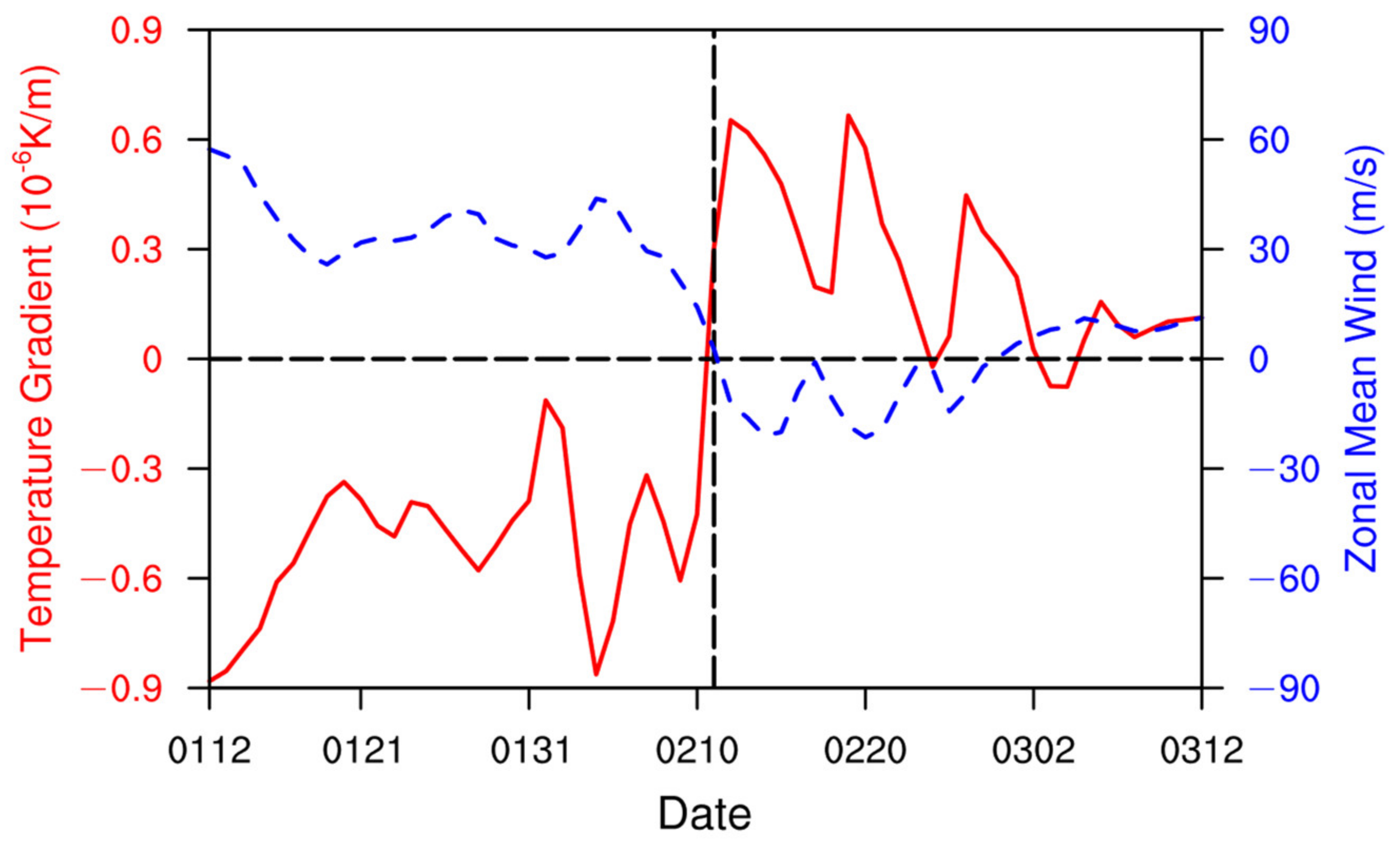


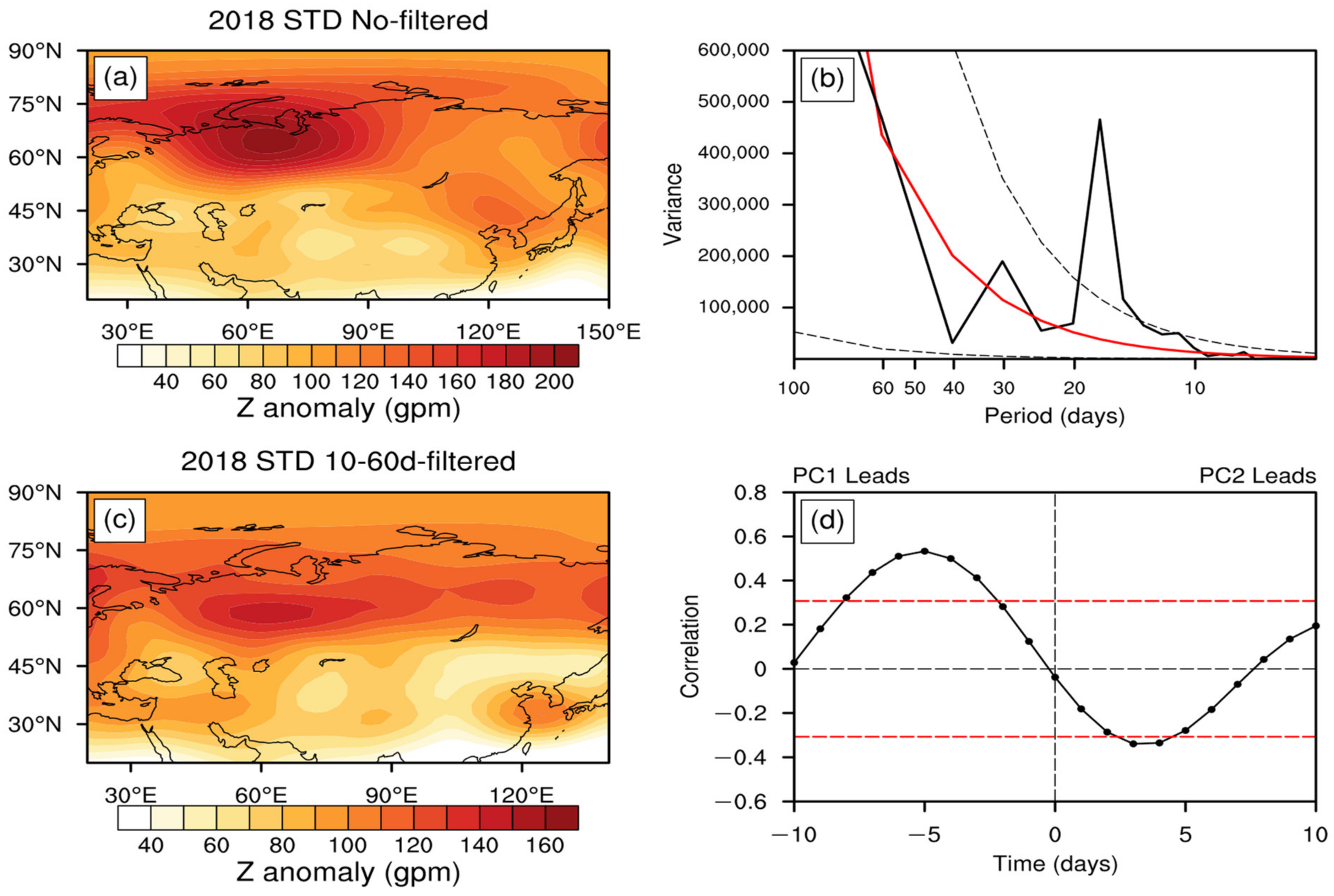
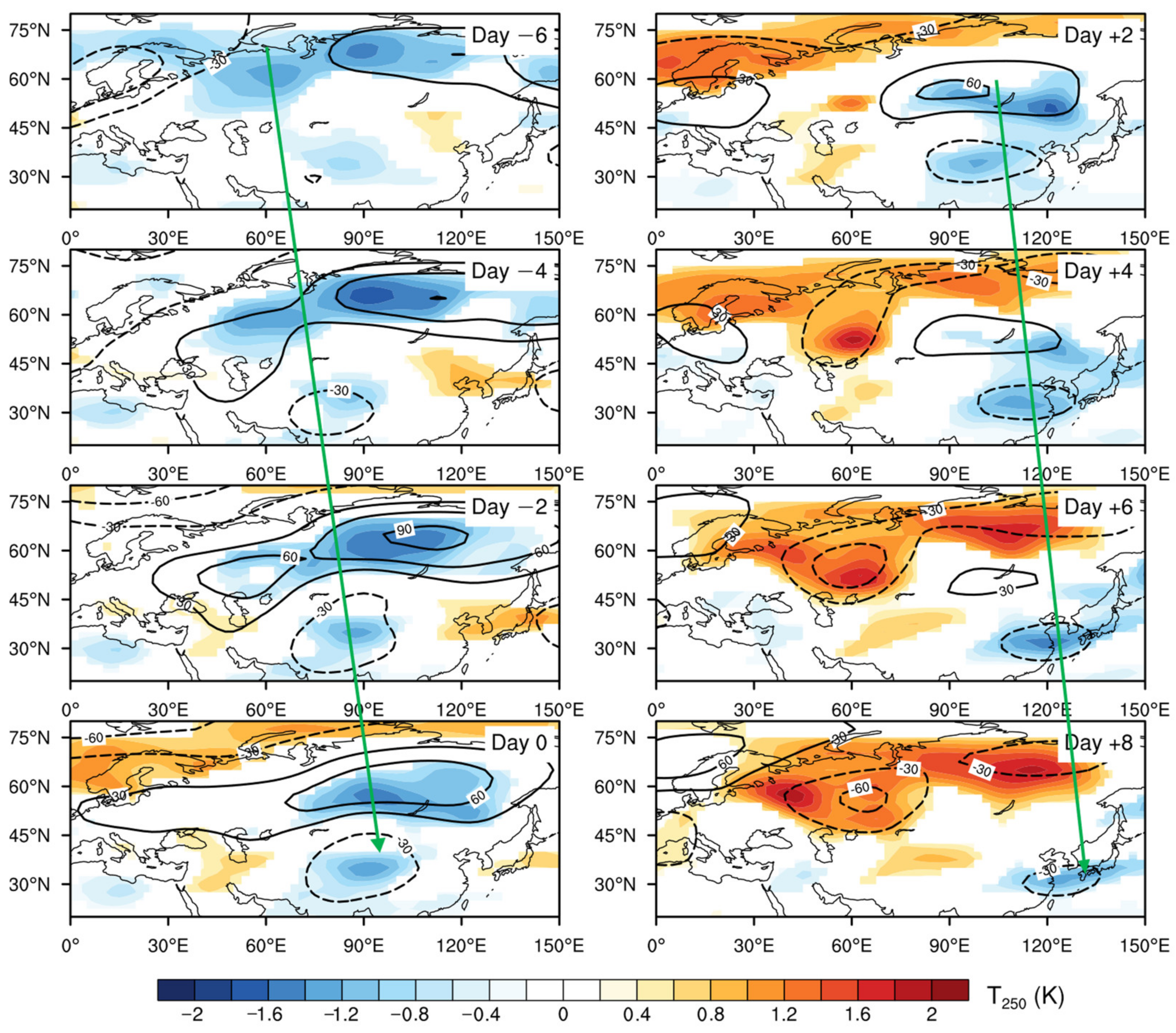
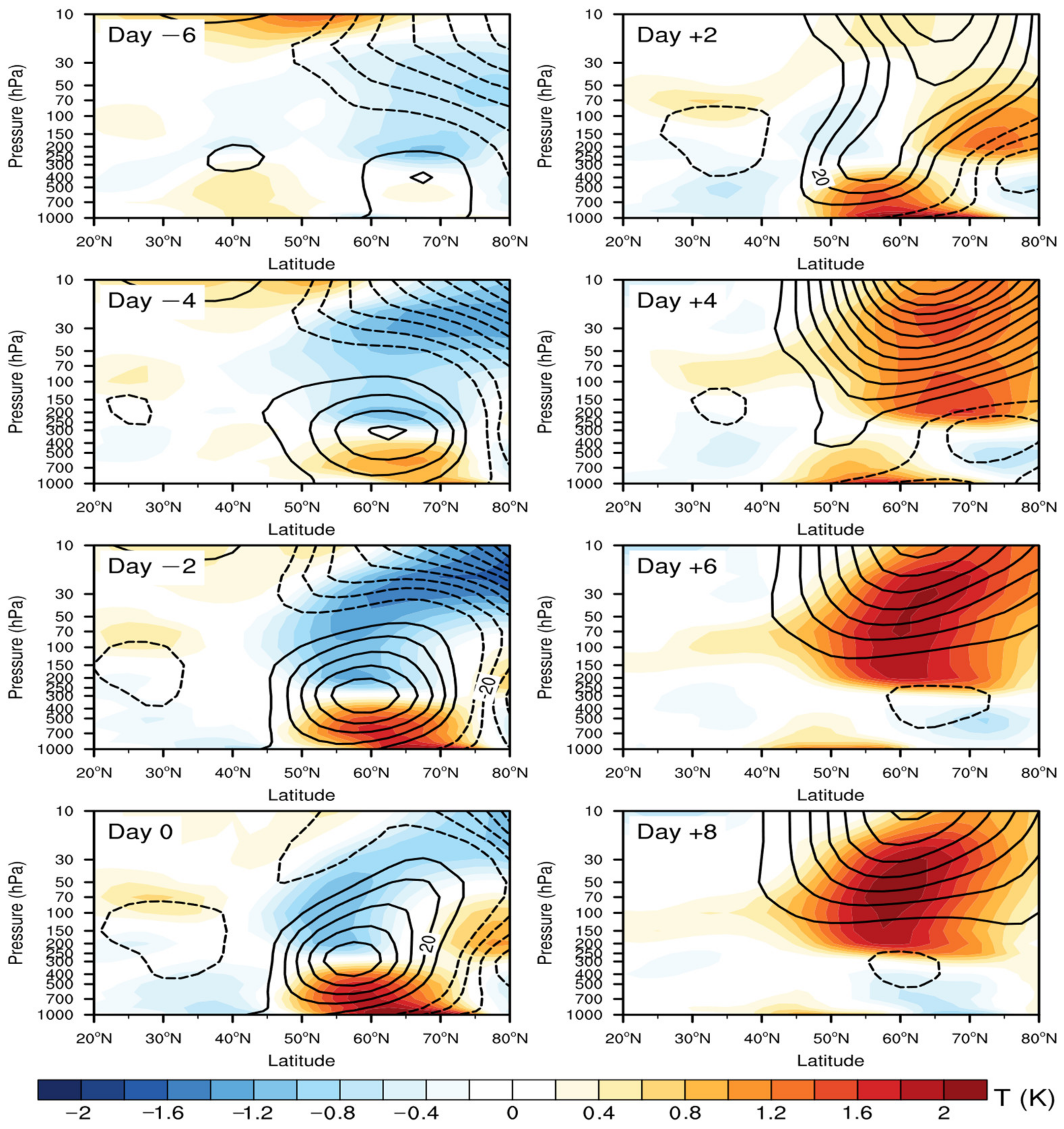
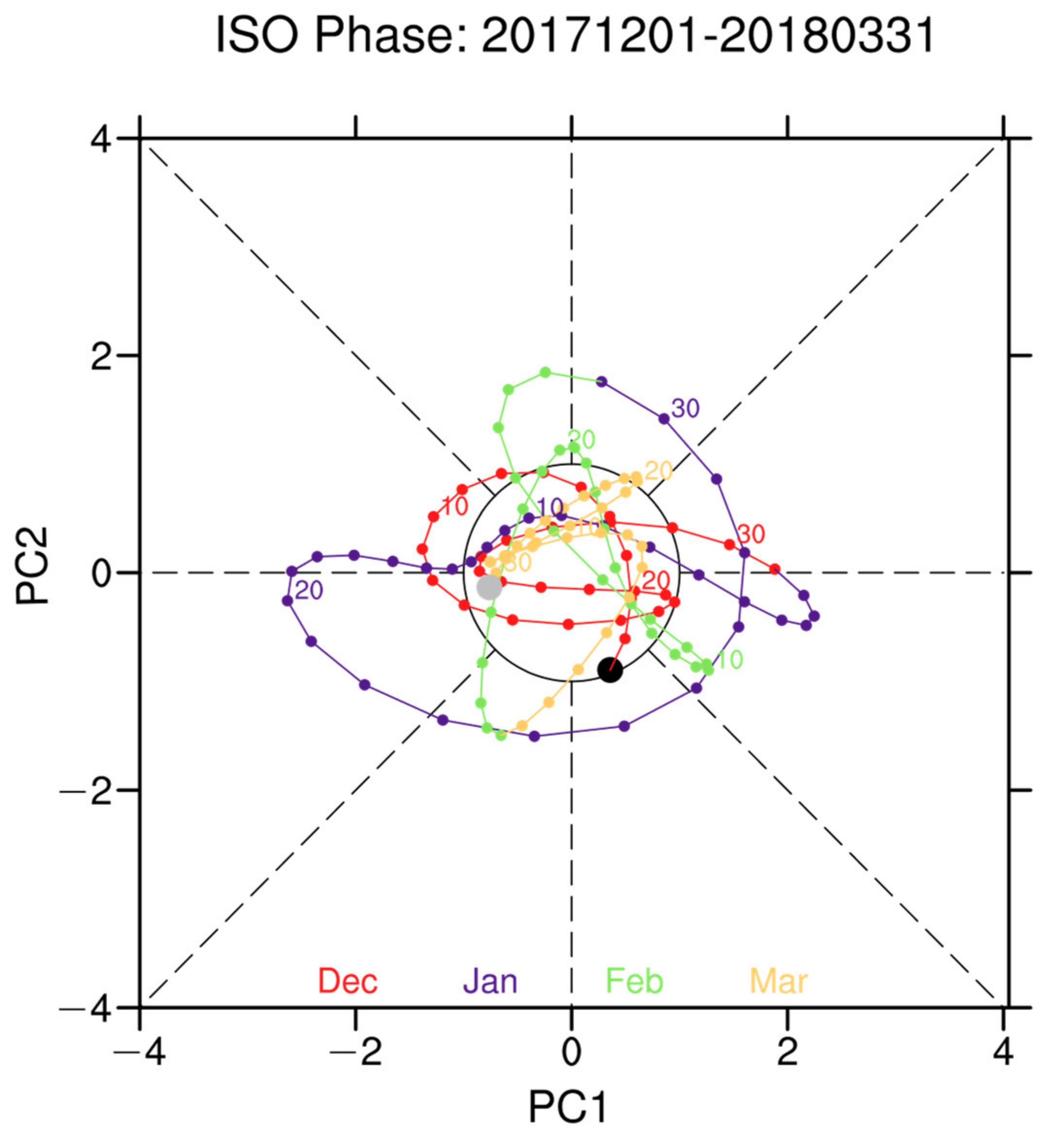


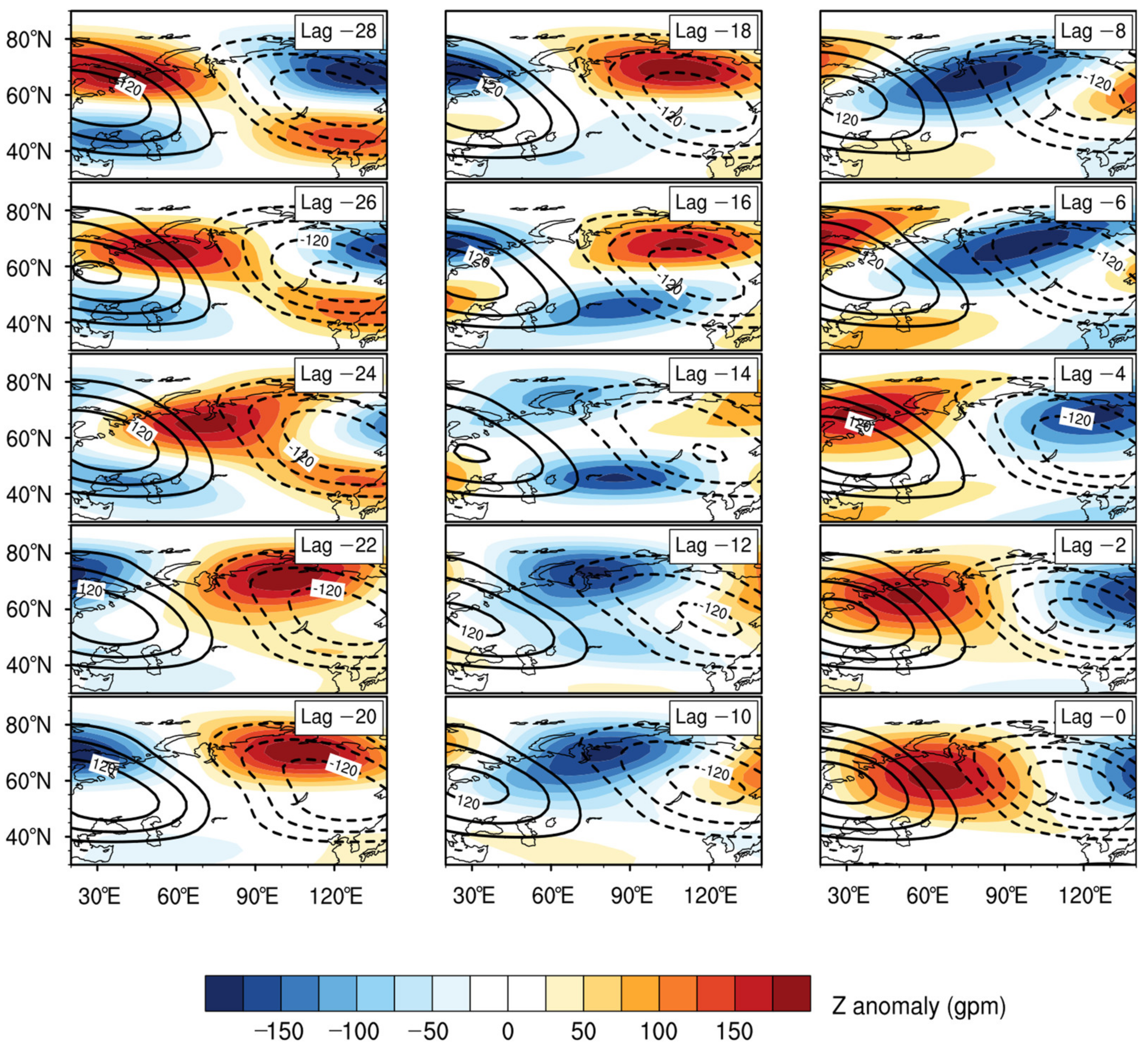
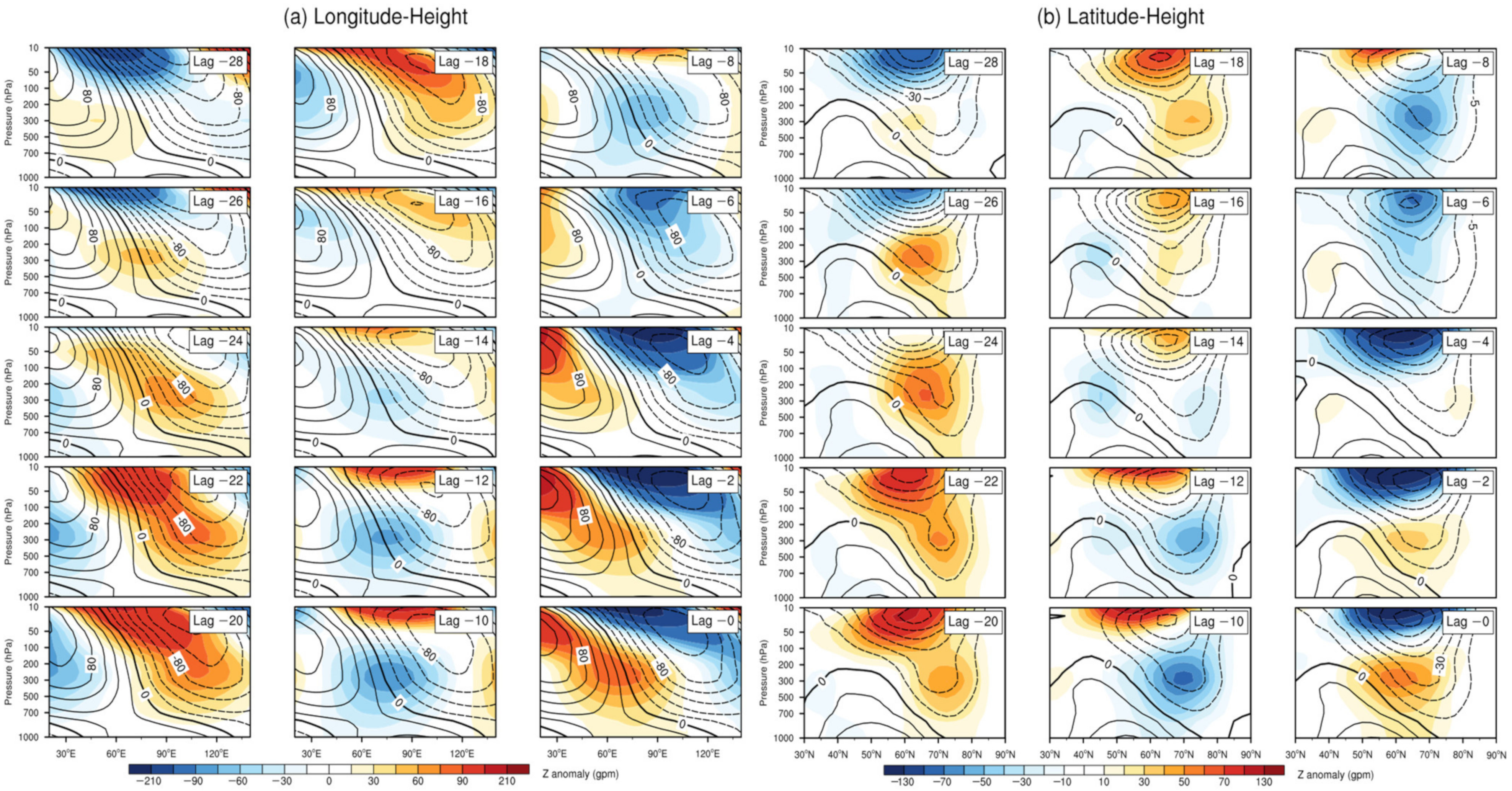
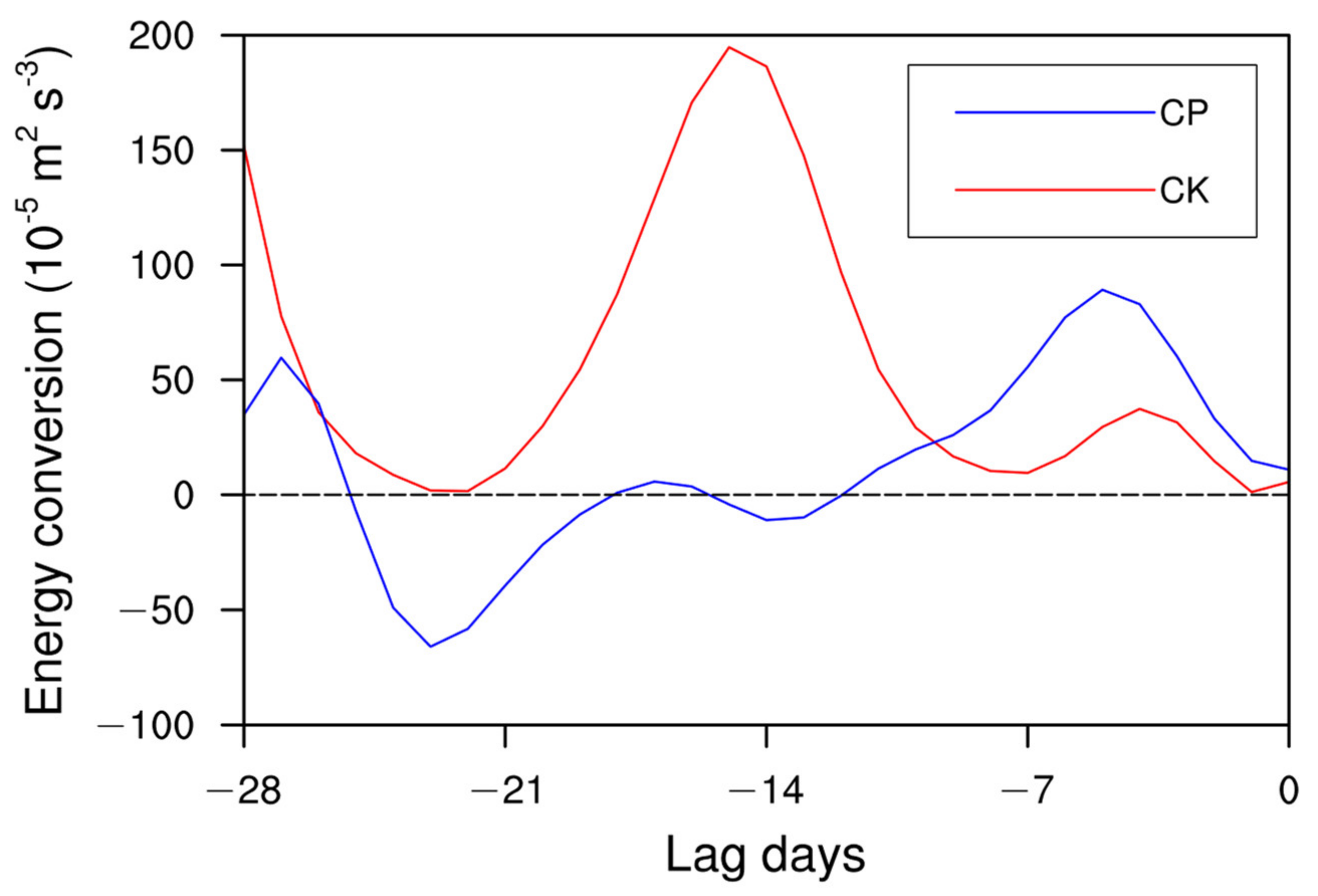
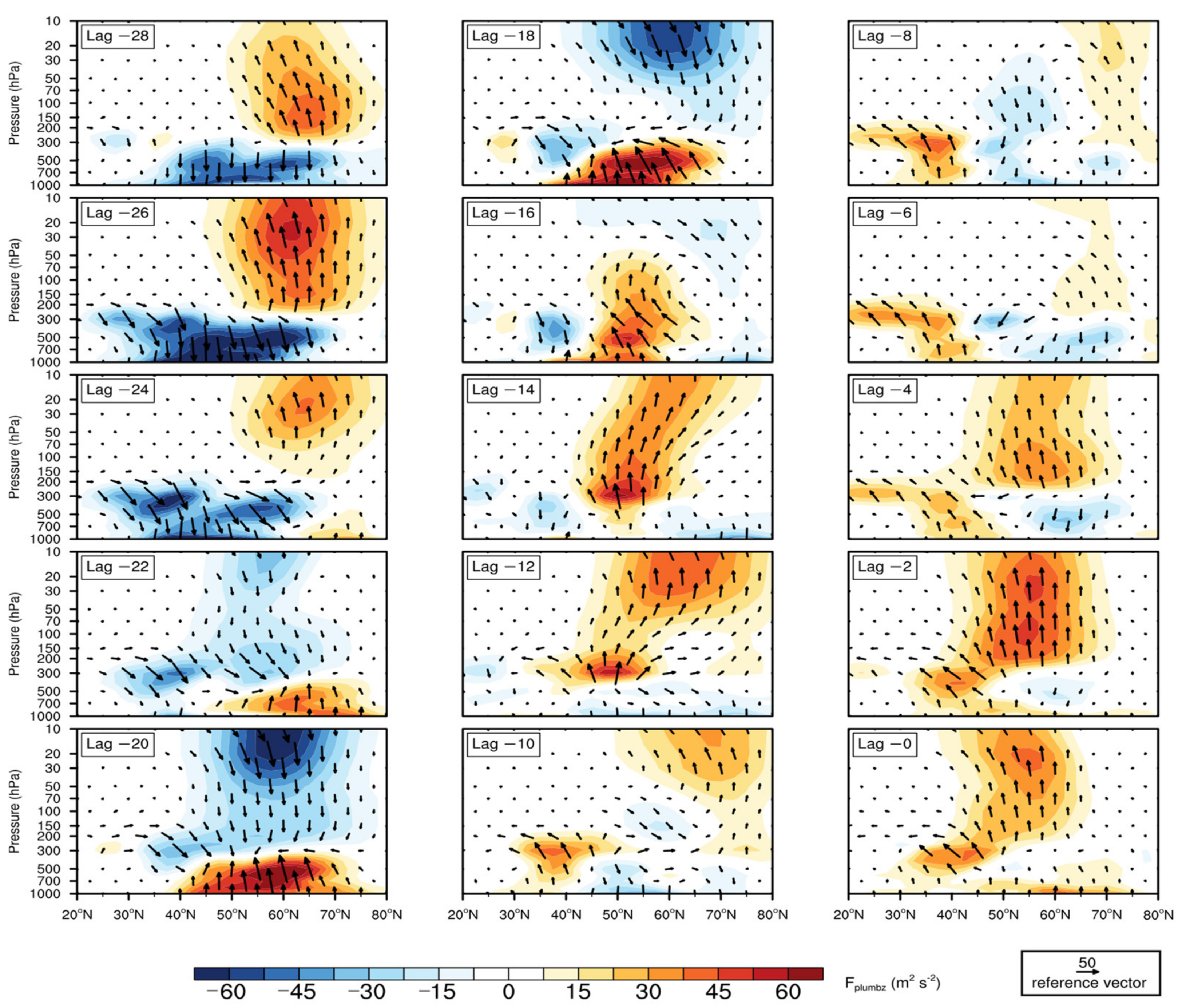
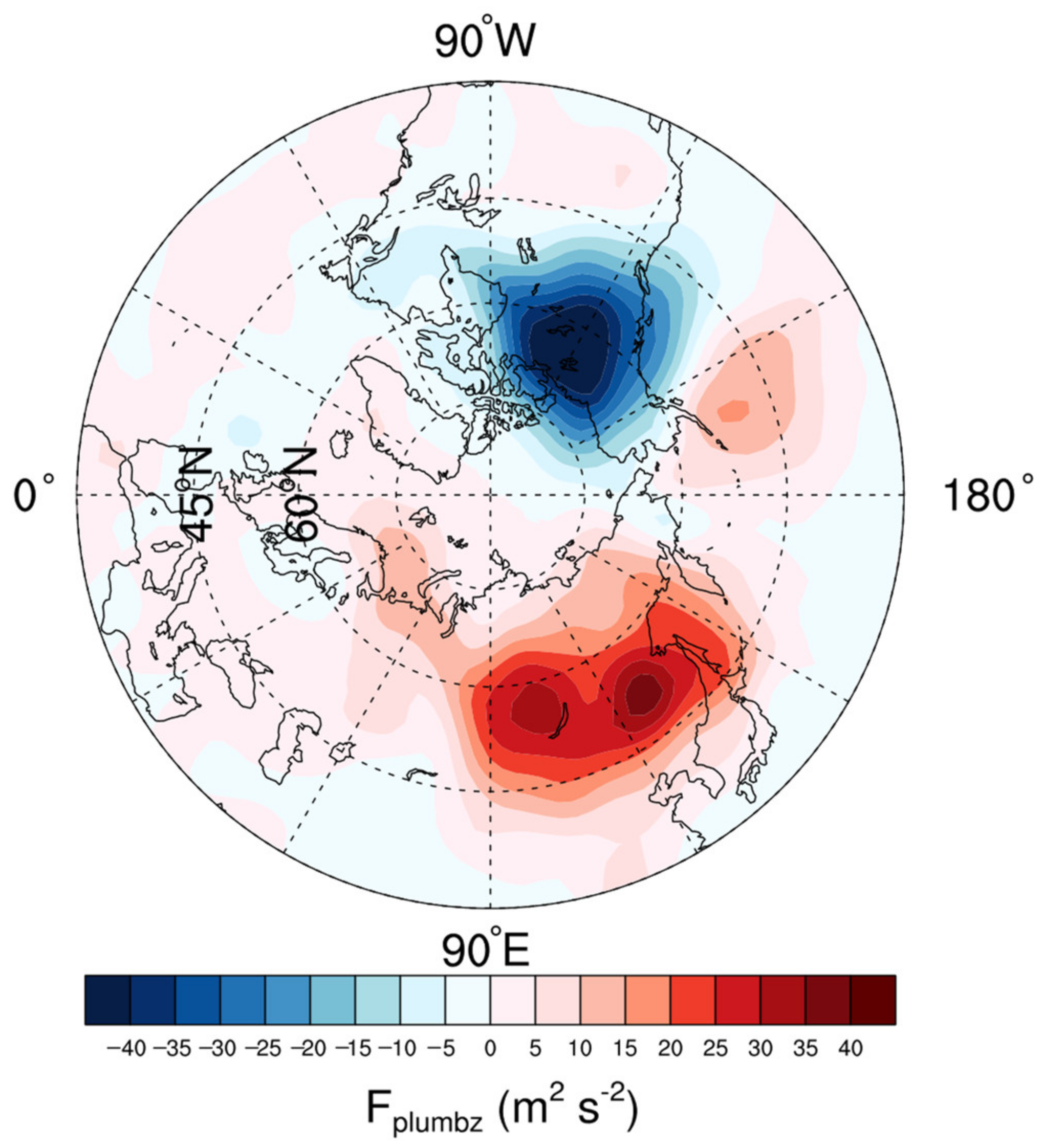
Publisher’s Note: MDPI stays neutral with regard to jurisdictional claims in published maps and institutional affiliations. |
© 2022 by the authors. Licensee MDPI, Basel, Switzerland. This article is an open access article distributed under the terms and conditions of the Creative Commons Attribution (CC BY) license (https://creativecommons.org/licenses/by/4.0/).
Share and Cite
Fan, L.; Yang, S.; Hu, J.; Li, T. Relationship between the Intraseasonal Oscillation over Mid-High-Latitude Eurasia and the Stratospheric Sudden Warming Event in February 2018. Remote Sens. 2022, 14, 1873. https://doi.org/10.3390/rs14081873
Fan L, Yang S, Hu J, Li T. Relationship between the Intraseasonal Oscillation over Mid-High-Latitude Eurasia and the Stratospheric Sudden Warming Event in February 2018. Remote Sensing. 2022; 14(8):1873. https://doi.org/10.3390/rs14081873
Chicago/Turabian StyleFan, Linjie, Shuangyan Yang, Jinggao Hu, and Tim Li. 2022. "Relationship between the Intraseasonal Oscillation over Mid-High-Latitude Eurasia and the Stratospheric Sudden Warming Event in February 2018" Remote Sensing 14, no. 8: 1873. https://doi.org/10.3390/rs14081873
APA StyleFan, L., Yang, S., Hu, J., & Li, T. (2022). Relationship between the Intraseasonal Oscillation over Mid-High-Latitude Eurasia and the Stratospheric Sudden Warming Event in February 2018. Remote Sensing, 14(8), 1873. https://doi.org/10.3390/rs14081873






